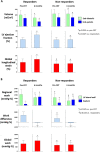Imaging predictors of response to cardiac resynchronization therapy: left ventricular work asymmetry by echocardiography and septal viability by cardiac magnetic resonance
- PMID: 32918449
- PMCID: PMC7599033
- DOI: 10.1093/eurheartj/ehaa603
Imaging predictors of response to cardiac resynchronization therapy: left ventricular work asymmetry by echocardiography and septal viability by cardiac magnetic resonance
Abstract
Aims: Left ventricular (LV) failure in left bundle branch block is caused by loss of septal function and compensatory hyperfunction of the LV lateral wall (LW) which stimulates adverse remodelling. This study investigates if septal and LW function measured as myocardial work, alone and combined with assessment of septal viability, identifies responders to cardiac resynchronization therapy (CRT).
Methods and results: In a prospective multicentre study of 200 CRT recipients, myocardial work was measured by pressure-strain analysis and viability by cardiac magnetic resonance (CMR) imaging (n = 125). CRT response was defined as ≥15% reduction in LV end-systolic volume after 6 months. Before CRT, septal work was markedly lower than LW work (P < 0.0001), and the difference was largest in CRT responders (P < 0.001). Work difference between septum and LW predicted CRT response with area under the curve (AUC) 0.77 (95% CI: 0.70-0.84) and was feasible in 98% of patients. In patients undergoing CMR, combining work difference and septal viability significantly increased AUC to 0.88 (95% CI: 0.81-0.95). This was superior to the predictive power of QRS morphology, QRS duration and the echocardiographic parameters septal flash, apical rocking, and systolic stretch index. Accuracy was similar for the subgroup of patients with QRS 120-150 ms as for the entire study group. Both work difference alone and work difference combined with septal viability predicted long-term survival without heart transplantation with hazard ratio 0.36 (95% CI: 0.18-0.74) and 0.21 (95% CI: 0.072-0.61), respectively.
Conclusion: Assessment of myocardial work and septal viability identified CRT responders with high accuracy.
Keywords: Myocardial scar; Cardiac resynchronization therapy; Dyssynchrony; Heart failure; Left bundle branch block; Myocardial work.
© The Author(s) 2020. Published by Oxford University Press on behalf of the European Society of Cardiology.
Figures








Comment in
-
Investigating myocardial work as a CRT response predictor is not a waste of work.Eur Heart J. 2020 Oct 14;41(39):3824-3826. doi: 10.1093/eurheartj/ehaa677. Eur Heart J. 2020. PMID: 32944764 No abstract available.
-
Scar imaging in the dyssynchronous left ventricle: Accuracy of myocardial metabolism by positron emission tomography and function by echocardiographic strain.Int J Cardiol. 2023 Feb 1;372:122-129. doi: 10.1016/j.ijcard.2022.11.042. Epub 2022 Nov 29. Int J Cardiol. 2023. PMID: 36460211
References
-
- Chung ES, Leon AR, Tavazzi L, Sun JP, Nihoyannopoulos P, Merlino J, Abraham WT, Ghio S, Leclercq C, Bax JJ, Yu CM, Gorcsan J 3rd, St John Sutton M, De Sutter J, Murillo J. Results of the predictors of response to CRT (PROSPECT) trial. Circulation 2008;117:2608–2616. - PubMed
-
- Ponikowski P, Voors AA, Anker SD, Bueno H, Cleland JGF, Coats AJS, Falk V, Gonzalez-Juanatey JR, Harjola VP, Jankowska EA, Jessup M, Linde C, Nihoyannopoulos P, Parissis JT, Pieske B, Riley JP, Rosano GMC, Ruilope LM, Ruschitzka F, Rutten FH, van der Meer P. 2016 ESC Guidelines for the diagnosis and treatment of acute and chronic heart failure: the Task Force for the diagnosis and treatment of acute and chronic heart failure of the European Society of Cardiology (ESC). Developed with special contribution of the Heart Failure Association (HFA) of the ESC. Eur Heart J 2016;37:2129–2200. - PubMed
-
- Vernooy K, Cornelussen RNM, Verbeek X, Vanagt WYR, van Hunnik A, Kuiper M, Arts T, Crijns H, Prinzen FW. Cardiac resynchronization therapy cures dyssynchronopathy in canine left bundle-branch block hearts. Eur Heart J 2007;28:2148–2155. - PubMed
-
- Prinzen FW, Augustijn CH, Allessie MA, Arts T, Delhass T, Reneman RS. The time sequence of electrical and mechanical activation during spontaneous beating and ectopic stimulation. Eur Heart J 1992;13:535–543. - PubMed
-
- Russell K, Eriksen M, Aaberge L, Wilhelmsen N, Skulstad H, Remme EW, Haugaa KH, Opdahl A, Fjeld JG, Gjesdal O, Edvardsen T, Smiseth OA. A novel clinical method for quantification of regional left ventricular pressure-strain loop area: a non-invasive index of myocardial work. Eur Heart J 2012;33:724–733. - PMC - PubMed
Publication types
MeSH terms
LinkOut - more resources
Full Text Sources
Medical
Research Materials

